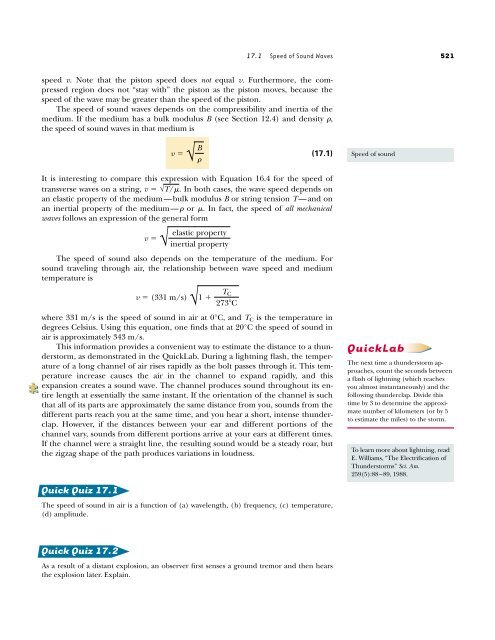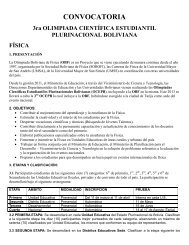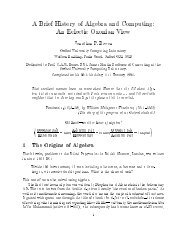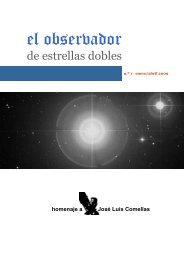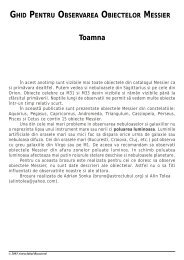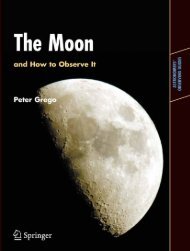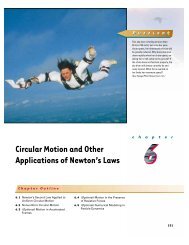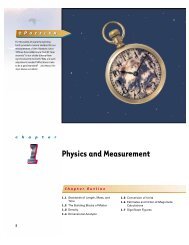You also want an ePaper? Increase the reach of your titles
YUMPU automatically turns print PDFs into web optimized ePapers that Google loves.
speed v. Note that the piston speed does not equal v. Furthermore, the compressed<br />
region does not “stay with” the piston as the piston moves, because the<br />
speed <strong>of</strong> the wave may be greater than the speed <strong>of</strong> the piston.<br />
The speed <strong>of</strong> sound waves depends on the compressibility and inertia <strong>of</strong> the<br />
medium. If the medium has a bulk modulus B (see Section 12.4) and density �,<br />
the speed <strong>of</strong> sound waves in that medium is<br />
17.1 Speed <strong>of</strong> <strong>Sound</strong> <strong>Waves</strong> 521<br />
(17.1)<br />
It is interesting to compare this expression with Equation 16.4 for the speed <strong>of</strong><br />
transverse waves on a string, v � !T/�. In both cases, the wave speed depends on<br />
an elastic property <strong>of</strong> the medium—bulk modulus B or string tension T—and on<br />
an inertial property <strong>of</strong> the medium—� or �. In fact, the speed <strong>of</strong> all mechanical<br />
waves follows an expression <strong>of</strong> the general form<br />
elastic property<br />
v � ! inertial property<br />
The speed <strong>of</strong> sound also depends on the temperature <strong>of</strong> the medium. For<br />
sound traveling through air, the relationship between wave speed and medium<br />
temperature is<br />
where 331 m/s is the speed <strong>of</strong> sound in air at 0°C, and T C is the temperature in<br />
degrees Celsius. Using this equation, one finds that at 20°C the speed <strong>of</strong> sound in<br />
air is approximately 343 m/s.<br />
This information provides a convenient way to estimate the distance to a thunderstorm,<br />
as demonstrated in the QuickLab. During a lightning flash, the temperature<br />
<strong>of</strong> a long channel <strong>of</strong> air rises rapidly as the bolt passes through it. This temperature<br />
increase causes the air in the channel to expand rapidly, and this<br />
expansion creates a sound wave. The channel produces sound throughout its entire<br />
length at essentially the same instant. If the orientation <strong>of</strong> the channel is such<br />
that all <strong>of</strong> its parts are approximately the same distance from you, sounds from the<br />
different parts reach you at the same time, and you hear a short, intense thunderclap.<br />
However, if the distances between your ear and different portions <strong>of</strong> the<br />
channel vary, sounds from different portions arrive at your ears at different times.<br />
If the channel were a straight line, the resulting sound would be a steady roar, but<br />
the zigzag shape <strong>of</strong> the path produces variations in loudness.<br />
Quick Quiz 17.1<br />
The speed <strong>of</strong> sound in air is a function <strong>of</strong> (a) wavelength, (b) frequency, (c) temperature,<br />
(d) amplitude.<br />
Quick Quiz 17.2<br />
v � ! B<br />
v � (331 m/s) ! 1 � T C<br />
273�C<br />
As a result <strong>of</strong> a distant explosion, an observer first senses a ground tremor and then hears<br />
the explosion later. Explain.<br />
�<br />
Speed <strong>of</strong> sound<br />
QuickLab<br />
The next time a thunderstorm approaches,<br />
count the seconds between<br />
a flash <strong>of</strong> lightning (which reaches<br />
you almost instantaneously) and the<br />
following thunderclap. Divide this<br />
time by 3 to determine the approximate<br />
number <strong>of</strong> kilometers (or by 5<br />
to estimate the miles) to the storm.<br />
To learn more about lightning, read<br />
E. Williams, “The Electrification <strong>of</strong><br />
Thunderstorms” Sci. Am.<br />
259(5):88–89, 1988.


